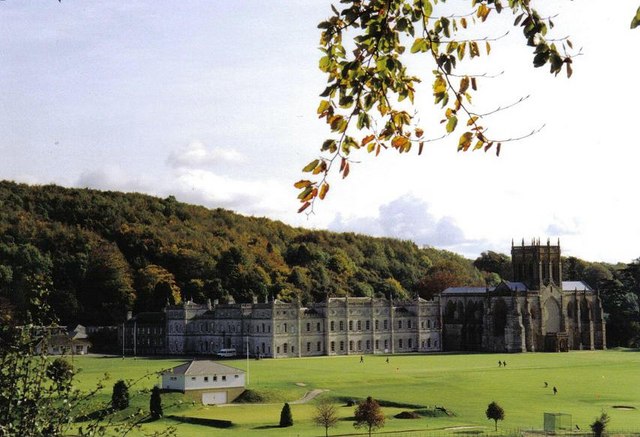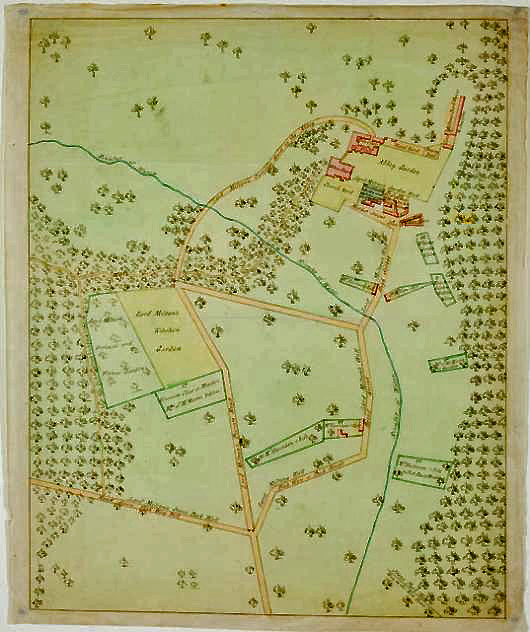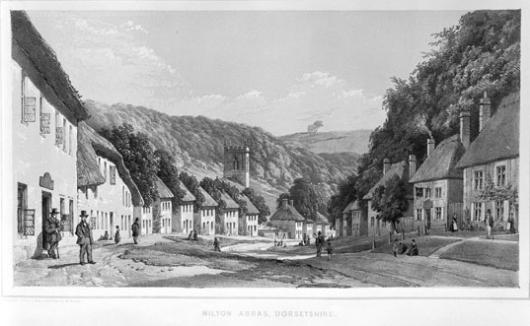Milton Abbey lies tucked away in an idyllic part of the country, amongst beautiful rolling hills in the heart of Dorset. About eight miles southwest of Blandford, between the villages of Milborne St. Andrew and Hilton, a church has stood here to the glory of God for over a thousand years. It now forms an integral part of Milton Abbey School but its history is also closely tied to the formation of the village of Milton Abbas.

© Copyright Chris Downer and licensed for reuse under this Creative Commons Licence.
The original collegiate church was founded c.933 AD by King Athelstan of Wessex, to commemorate the death at sea of his brother Edwin, for which he was said to have been responsible. To support the church, Athelstan granted it sixteen manors in Dorset. In 964, King Edgar dismissed the secular priests and replaced them with Benedictine monks from Glastonbury, who sustained the monastic life for several centuries. Over time the abbey grew, as did the large market town outside its gates. The monks made additions to the church, which included a wooden bell tower, reliquaries, and elaborate shrines and tombs. After lightning struck the spire during a violent storm in 1309, the church was consumed by a fire in which the abbey's documents, books and relics were all destroyed.
A new abbey church was soon begun; although never fully completed, it reached its present size principally under the guidance of Abbot William Middleton at the turn of the 15th century and the village next to it was also often referred to as Middleton. Building at the abbey continued until its six centuries of monasticism came to an abrupt halt with the dissolution of the monastries in 1539. The monks were dispersed and within a year the monastery's manors and other properties had been sold off.
Sir John Tregonwell, a lawyer who had helped arrange Henry VIII's divorce from Catherine of Aragon and at the Dissolution acted as commissioner taking the surrenders of monasteries, bought the Abbey and estate in 1540 for £1,000 and converted it into a private house. He died in 1565 but the Tregonwell family lived at Milton Abbey for a century afterwards. Mary Tregonwell inherited in 1680, and in 1696 she married a naturalised Swede, Jacob Bancks, who had previously served in the Royal Navy. They had two children, one of whom, Jacob, inherited the estate in 1724. He had a short life, and when he died in 1737 the Milton estate passed to John Strachan, the son of a female cousin. After several legal wrangles, he was allowed to sell the estate in 1752 to Joseph Damer.
Damer was a wealthy and ambitious man whose fortune had descended from a great-uncle. In 1742, he married Caroline Sackville, daughter of the first Duke of Dorset; on Caroline's death in 1755, Damer commissioned the Italian sculptor Carlini to make a monument to mourn her, which today stands in the north transept of the Abbey.
Damer's influence on Milton Abbey was considerable. On buying the estate he set about a grand scheme to reshape the valley in which it lay. He planned to remove the old town south of the abbey and to replace the decaying abbey buildings with a great house suited to its surroundings and his position. The following map, dating from the 1760s, reveals the position of the village and house, plus the layout of the estate, shortly before Lord Milton’s re-planning. Most of the village was sited just south of the old abbey church, a fragment of which remained. The map reveals the higgledy-piggledy nature of the estate: roads meander; cottages are dotted here and there; and smallholdings are scattered throughout.

© Copyright RIBA British Architectural Library Drawings & Archives Collection.
He hired, first, John Vardy (1718-1765), who had constructed the Horse Guards in London and who worked intermittently on the Dorset project and a house for Damer in Park Lane. After Damer was created Baron Milton in 1764, he enlisted the great landscaper Lancelot 'Capability' Brown to design the grounds, and, following the death of Vardy in 1765, the famed architect Sir William Chambers (1723-1796) to create an appropriate house in the Gothic style, much against Chambers' tastes. Following frequent quarrels with his client chambers resigned, leaving the completion of the interior to James Wyatt, who also 'restored' the Abbey Church. The result is the impressive Gothic mansion in its valley setting, which in time attracted three royal visits.
Even as Lord Milton, Damer found that his removal of the town, house by house as the leases fell in or the occupants moved, did not go unopposed; one tennant, a lawyer, stubbornly remained but was flooded out when the sluice gates of the old abbey pond above the town were opened. An artists impression painted in the 1950's by Commander Hodgekinson headmaster of Milton Abbey school is displayed in the church but it is not clear whether this is based on any historical fact. Whatever Lord Milton's intentions in the case, the tenant took him to court and won. But by 1779 Damer had razed the entire town of Middleton and created a new model village on a site half a mile to the southeast. This was a huge project over many years and attracted labour from surrounding villages to landscape the estate, build new roads and move the village. Labourers were only paid a daily rate however and much of the landscaping etc was carried out during the summer. This led to many labourers having children born during the summer months baptised at Milton when they had work but back in their home parish during the winter when they had to return to their place of settlement to get support for the family.

© Copyright RIBA British Architectural Library Drawings & Archives Collection.
After Damer's death in 1798, at the age of 80, the estate passed to his son, George, and then to Damer's daughter Caroline. When she died in 1828 it passed to Henry Dawson Damer RN whose sole heir sold the estate in 1852 to Charles Joachim, Baron Hambro, a merchant banker from Denmark who made Milton Abbey his seat. Hambro commissioned Sir George Gilbert Scott to restore the Abbey Church in 1865, saving the church from potential ruin. Through their eighty years at Milton Abbey the Hambros saw the trees and shrubs planted by Capability Brown grow to their full maturity, especially under the loving care of Sir Everard Hambro. In 1932 the estate was sold and divided up. The Ecclesiastical Commissioners bought the Abbey and for some time the house was a healing centre. In 1953 the grounds were bought by a trust to establish a school, Milton Abbey which flourishes today. The school has five houses - fittingly named Athelstan, Tregonwell, Bancks, Damer and Hambro.
Sources & Links:-
(1).
Milton Abbey school website.
(2). RIBA British Architectural Library Drawings & Archives Collection
(3).
Astoft
A site based around photographs, primarily of architecture, with descriptions. Currently over 8,000 photos
(4).
Weymouth pictures
(5).
Dorset photos